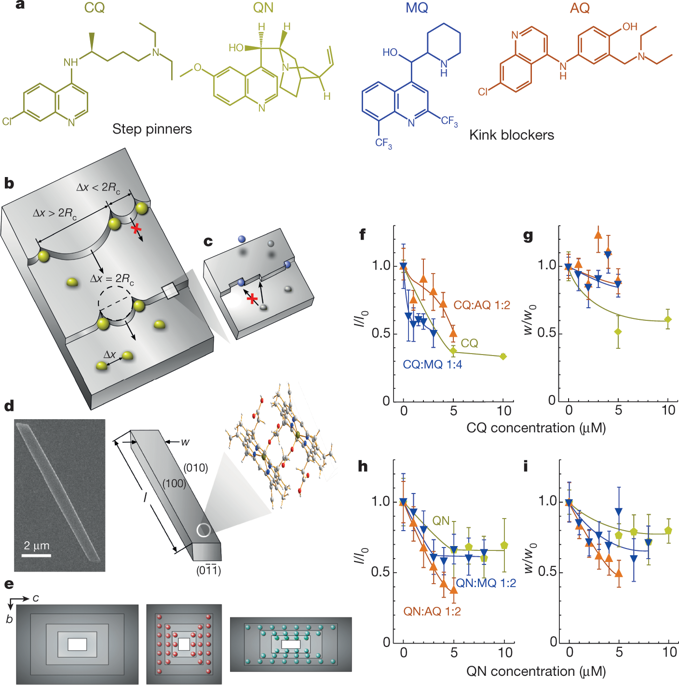Nature ( IF 64.8 ) Pub Date : 2020-01-15 , DOI: 10.1038/s41586-019-1918-4 Wenchuan Ma 1 , James F Lutsko 2 , Jeffrey D Rimer 1, 3 , Peter G Vekilov 1, 3

|
Ubiquitous processes in nature and the industry exploit crystallization from multicomponent environments1,2,3,4,5; however, laboratory efforts have focused on the crystallization of pure solutes6,7 and the effects of single growth modifiers8,9. Here we examine the molecular mechanisms employed by pairs of inhibitors in blocking the crystallization of haematin, which is a model organic compound with relevance to the physiology of malaria parasites10,11. We use a combination of scanning probe microscopy and molecular modelling to demonstrate that inhibitor pairs, whose constituents adopt distinct mechanisms of haematin growth inhibition, kink blocking and step pinning12,13, exhibit both synergistic and antagonistic cooperativity depending on the inhibitor combination and applied concentrations. Synergism between two crystal growth modifiers is expected, but the antagonistic cooperativity of haematin inhibitors is not reflected in current crystal growth models. We demonstrate that kink blockers reduce the line tension of step edges, which facilitates both the nucleation of crystal layers and step propagation through the gates created by step pinners. The molecular viewpoint on cooperativity between crystallization modifiers provides guidance on the pairing of modifiers in the synthesis of crystalline materials. The proposed mechanisms indicate strategies to understand and control crystallization in both natural and engineered systems, which occurs in complex multicomponent media1,2,3,8,9. In a broader context, our results highlight the complexity of crystal–modifier interactions mediated by the structure and dynamics of the crystal interface.
中文翻译:

晶体生长调节剂之间的拮抗协同作用
自然界和工业中普遍存在的过程利用多组分环境1,2,3,4,5的结晶;然而,实验室的努力集中在纯溶质的结晶6,7和单一生长调节剂的影响8,9上。在这里,我们研究了成对的抑制剂在阻止血红素结晶时所采用的分子机制,血红素是一种与疟原虫生理学相关的有机模型化合物10,11。我们结合使用扫描探针显微镜和分子建模来证明抑制剂对,其成分采用不同的血红素生长抑制机制、扭结阻断和阶梯固定12,13,取决于抑制剂组合和应用浓度,表现出协同和拮抗协同作用。两种晶体生长调节剂之间的协同作用是预期的,但血红素抑制剂的拮抗协同作用并未反映在当前的晶体生长模型中。我们证明了扭结阻滞剂降低了阶梯边缘的线张力,这有助于晶体层的成核和通过阶梯销产生的栅极的阶梯传播。结晶改性剂之间协同作用的分子观点为结晶材料合成中改性剂的配对提供了指导。所提出的机制表明了在自然和工程系统中理解和控制结晶的策略,这些结晶发生在复杂的多组分介质中 1,2,3,8,9. 在更广泛的背景下,我们的结果突出了由晶体界面的结构和动力学介导的晶体-改性剂相互作用的复杂性。


























 京公网安备 11010802027423号
京公网安备 11010802027423号